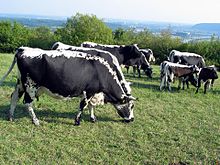Vosges cattle
The Vosges cattle are an endangered ancient domestic breed. Their further breeding and thus their conservation is promoted both by the French state and by funding from the European Union (EU). Other institutions are also dedicated to preserving the species, such as the Naturland Foundation Saar , whose large nature reserve "Wolferskopf" near the Saarland city of Merzig has a herd of suckler cows with Vosges cattle.
origin
According to tradition, the breed originated in the 17th century. At the time of the Thirty Years War , Scandinavian cattle are said to have been brought to the Vosges and successfully bred there. The robust breed was able to adapt well to the high and low mountain landscape of the Vosges with their special climatic conditions and their lime-poor granite formations . Their distribution area gradually extended to northern Alsace and Lorraine . The Vosges cattle dominated the other domestic cattle breeds ; In the Alsatian Münstertal near Munster (Haut-Rhin), for example, 80 percent of the cattle population was characterized by this species. In the years that followed, the breed, like many others, was displaced by special new breeds that either provided significantly improved milk yields or optimized meat.
description
The Vosges cattle are of medium size. It is characterized by the basic colors black and white. From the forehead over the entire back to the base of the tail, there is an irregularly bordered white stripe that becomes wider in the pelvic area. The flanks, like the side neck, are colored black. From the chest to the pubic area, a white stripe extends across the entire abdomen to the white tail. The head color of the Vosges cattle can vary considerably; it is usually speckled in black and white. The cattle's lower legs are usually white, their thighs and their belly have characteristic, irregularly shaped black spots. The hindquarters of the animal are quite strongly developed. Its horns are usually colored white, but always have a small black tip.
The advantages of Vosges cattle are described as follows: undemanding, easy calving with good fertility, hard and resistant, very good milk yield and excellent calf growth, early maturity, very good meat quality. The cows have a live weight of up to 600 kg with an instep height of up to 135 cm, the bulls can weigh up to 1000 kg and reach an instep height of 140 cm.
See also
literature
- Hans Hinrich Sambraus: Endangered farm animal breeds. Their breeding history, use and preservation. 2nd Edition. Ulmer, Stuttgart 1999, ISBN 3-8001-4131-0 .
swell
Individual evidence
- ^ Rinderzuchtverband Sachsen-Anhalt eG, Vogesenrind ( Memento from September 13, 2007 in the Internet Archive )

